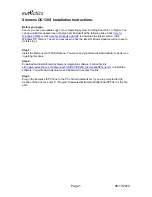
268
Chapter 13: Designing and Optimizing a ColdFusion Application
About applications
The term
application
can mean many things. An application can be as simple as a guest book or as
sophisticated as a full Internet commerce system with catalog pages, shopping carts, and
reporting.
However, an application has a specific meaning in ColdFusion. A ColdFusion application consists
of one or more ColdFusion pages that work together and share a common set of resources. In
particular, the application shares an application name as specified in a
cfapplication
tag, and all
pages in the application share variables in the Application scope. What appears to a user to be a
single application, for example, a company’s website, might consist of multiple ColdFusion
applications.
While there are no definite rules as to how you represent your web application as a ColdFusion
application or applications, the following guidelines are useful:
•
Application pages share a common general purpose. For example, a web storefront is typically a
single ColdFusion application.
•
Many, but not necessarily all, pages in a ColdFusion application share data or common code
elements, such as a single login mechanism.
•
Application pages share a common look and feel, often enforced by using common code
elements, such as the same header and footer pages, and a common error message template.
This chapter describes the tools that ColdFusion provides to create an application, and presents
information on how you can develop and optimize your application.
Elements of a ColdFusion application
Before you develop a ColdFusion application, you must determine how to structure the
application and how to handle application-wide needs and issues. In particular, you must consider
all of the following:
•
The overall application framework
•
Application-level settings and functions
•
Reusable application elements
•
Shared variables
•
Application security and user identification
The following sections introduce these application elements and provide references to more
detailed information.
The application framework
The application framework is the overall structure of the application and how your directory
structure and application pages reflect that structure. You can use a single application framework
to structure multiple ColdFusion applications into a single website or Internet application. You
can structure a ColdFusion application using many methodologies. For example, the FuseBox
application development methodology is one popular framework for developing ColdFusion web
applications. (For more information on FuseBox, see www.fusebox.org.)
Summary of Contents for COLDFUSION MX 61-DEVELOPING COLDFUSION MX
Page 1: ...Developing ColdFusion MX Applications...
Page 22: ...22 Contents...
Page 38: ......
Page 52: ...52 Chapter 2 Elements of CFML...
Page 162: ......
Page 218: ...218 Chapter 10 Writing and Calling User Defined Functions...
Page 250: ...250 Chapter 11 Building and Using ColdFusion Components...
Page 264: ...264 Chapter 12 Building Custom CFXAPI Tags...
Page 266: ......
Page 314: ...314 Chapter 14 Handling Errors...
Page 344: ...344 Chapter 15 Using Persistent Data and Locking...
Page 349: ...About user security 349...
Page 357: ...Security scenarios 357...
Page 370: ...370 Chapter 16 Securing Applications...
Page 388: ...388 Chapter 17 Developing Globalized Applications...
Page 408: ...408 Chapter 18 Debugging and Troubleshooting Applications...
Page 410: ......
Page 426: ...426 Chapter 19 Introduction to Databases and SQL...
Page 476: ...476 Chapter 22 Using Query of Queries...
Page 534: ...534 Chapter 24 Building a Search Interface...
Page 556: ...556 Chapter 25 Using Verity Search Expressions...
Page 558: ......
Page 582: ...582 Chapter 26 Retrieving and Formatting Data...
Page 668: ......
Page 734: ...734 Chapter 32 Using Web Services...
Page 760: ...760 Chapter 33 Integrating J2EE and Java Elements in CFML Applications...
Page 786: ...786 Chapter 34 Integrating COM and CORBA Objects in CFML Applications...
Page 788: ......
















































